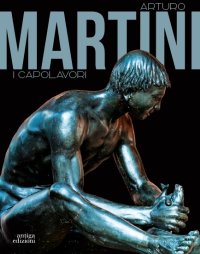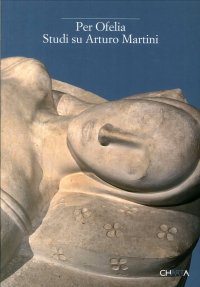Arturo Martini. I capolavori
Treviso, Museo “luigi Bailo”, 31 marzo - 30 luglio 2023.
A cura di Stringa Nico e Fabrizio Malachin.
Cornuda, 2023; br., pp. 278, ill. col., cm 23x29.
prezzo di copertina: € 33.00
|
Libri compresi nell'offerta:
Arturo Martini. I capolavori
Treviso, Museo “luigi Bailo”, 31 marzo - 30 luglio 2023.
A cura di Stringa Nico e Fabrizio Malachin.
Cornuda, 2023; br., pp. 278, ill. col., cm 23x29.
OMAGGIO (prezzo di copertina: € 33.00)
Studi su Arturo Martini. Per Ofelia
A cura di Matteo Ceriana e Claudia Gian Ferrari.
Milano, Atti del Covegno, 19 maggio 2008.
Milano, 2009; br., pp. 136, 97 ill. b/n, cm 17x24.
OMAGGIO (prezzo di copertina: € 29.00)
Canova. L'invenzione della gloria. Disegni, dipinti e sculture.
Genova, Palazzo Reale, 16 aprile - 24 luglio 2016.
A cura di Giuliana Ericani e Franceasco Leone.
Roma, 2016; br., pp. 306, ill. col., tavv. col., cm 23x30.
OMAGGIO (prezzo di copertina: € 35.00)
Betye Saar. Uneasy Dancer
Fondazione Prada
A cura di Mainetti M.
Milano, Fondazione Prada, 15 September - 8 January 2017.
English Edition with Italian translations of the essays.
Testo Italiano e Inglese.
Milano, 2016; br., pp. 320, ill., cm 17x22,5.
ISBN: 88-87029-67-9 - EAN13: 9788887029673
Soggetto: Pittura e Disegno - Monografie,Saggi (Arte o Architettura),Scultura e Arti Decorative - Monografie
Periodo: 1960- Contemporaneo
Testo in: 

Peso: 1 kg
"Uneasy Dancer" is an expression Betye Saar has used to define both herself and her artistic practice. In her own words, "my work moves in a creative spiral with the concepts of passage, crossroads, death and rebirth, along with the underlying elements of race and gender." This process implies "a stream of consciousness" that explores the ritualized mysticism present in recovering personal stories and iconographies from everyday objects and images. Several key elements lie at the center of her artistic practice: an interest in the metaphysical, the representation of feminine memory, and African-American identity which, in her work, takes on takes on evocative and unusual forms. As Saar has said about her work, "It was really about evolution rather than revolution, about evolving the consciousness in another way and seeing black people as human beings instead of the caricatures or the derogatory images."
Through her confident usage of found objects, personal memorabilia and derogatory images that evoke denied or distorted narratives, Saar developed a powerful social critique that challenges racial and sexist stereotypes deeply rooted in American culture. In the 1970s, her assemblages began to grow in scale, ultimately becoming substantial installations and immersive environments that speak to an approach uniting spiritual beliefs and faiths of all kind - from the intimate and the mysterious to the universal - alongside politicized convictions.
Curator Elvira Dyangani Ose notes, "Saar's works blur boundaries between art and life, between physical and metaphysical. Spirituality in her work, does not only resides in the works with which she addresses her concerns and her knowledge on a myriad of traditions. On the contrary, it is to be found in the artistic exercise of transforming common material in a sort of evocative new imagery, involving the viewer in reminiscent fabulations of the real."
"Uneasy Dancer" expands holistically on fundamental tenants of Saar's practice including memory, mysticism and the construction of socio-political identifiers. This is none so much apparent than in the seminal work The Alpha and the Omega (2013-2016), a circular environment alluding to the initiatory journey and the experience of human life. This installation was specifically conceived for "Uneasy Dancer", and will include a number of newly created elements denoting the idea of representing the whole of anything, from beginning to end.
Earlier assemblages involving objects inserted within boxes or suitcases, like Record for Hattie (1975) and Calling Card (1976), take on a performative dimension even when rendered in an intimate scale. Sculptural floor works utilizing cages, such as Domestic Life (2007) and Rhythm and Blues (2010), simultaneously represent the physical and metaphorical condition of segregation, and the increased need for resistance and survival. These works specifically reference African-American folklore, combining a political dimension with a spiritual vision that draws on a multiplicity of traditions stemming from Africa, Asia, America and Europe.
The exhibition additionally highlights a series utilizing work tools and elements of domestic life, such as washboards and scales, alongside either found or inherited photographs, as in the works Mystic Window for Leo (1966), The Phrenologer's Window (1966) and A Call to Arms (1997). Spanning the length of several decades, these aforementioned works reveal, on one hand, an intimate and autobiographical condition, whilst on the other, allude to an imaginative, fantastical dimension. Saar's use of photography, treated here as a found object rather than a singular flatness, in works such as Migration: Africa to America I (2006) becomes a way to celebrate both the beauty and artifices of femininity.
Throughout her career Saar has engaged with a practice which, in addition to opposing male chauvinist and Euro-centric thinking, supports a humanistic perspective that reconsiders notions of the individual, family, community and society.

Saluti da... Vallombrosa e Saltino attraverso le cartoline d'epoca
I frati cappuccini di Casola Valsenio. Il convento di San Francesco
Il Ratto di Proserpina di Nicolas Mignard ed Altri Dipinti Antichi









